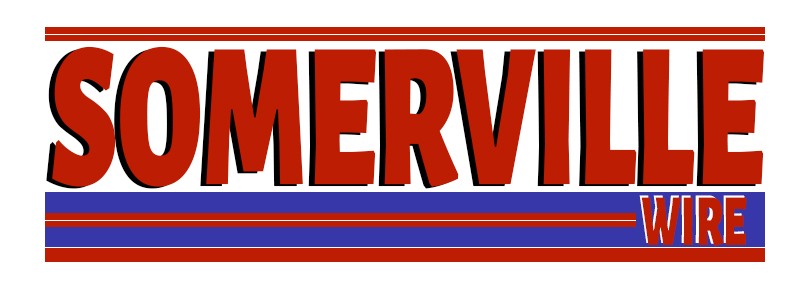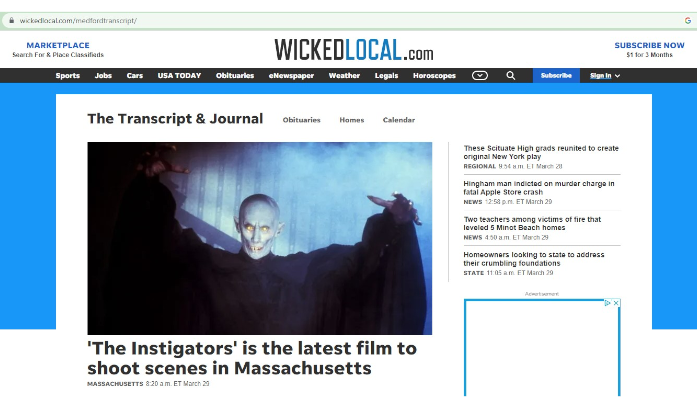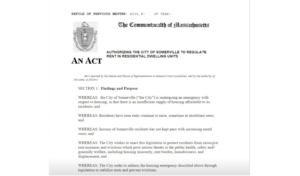All surviving local news outlets combined produce one-third the number of original news articles weekly that the Somerville Journal did a decade back
(Somerville Wire) – Since our reporter Ryan DiLello is (mostly) off this week, I think it’s a good time for me to give readers an overview of the state of Somerville news media.
Many of you have seen recent missives from me asking for money to support the Somerville Wire in which I explain that—as local news outlets fall have fallen like dominos due to a variety of factors over the last quarter century—more and more US cities, towns, and counties every year are becoming “news deserts” with no professionally-produced reporting about issues of the day. And I’ve added that while it may seem like this is a distant threat to a relatively well-off municipality like Somerville, it is in fact a real and present danger.
This time out, I’d like to get very specific by comparing what kind of regular local news coverage Somerville once got week to week versus what it gets now. Spoiler alert: We’re in a bad situation that can get worse at any time.
For many years, the flagship news outlet hereabouts was the (ultimately Gannett-owned) Somerville Journal. The easiest way to show what news coverage we have lost is to compare the weekly output of that single (formerly independent) weekly newspaper from over a decade back with the current output of all local news outlets regularly covering our city today—keeping in mind that there was other news media that overlapped with the old Journal that I’m not even discussing that at times produced several more news articles about Somerville every week.
Fortunately, the last longtime Journal editor at the end of its tenure as a real news outlet (prior to Gannett reducing it to its current pathetic zombie state), Kat Powers, is still involved with local media as executive director of the Somerville Media Center. And I am proud to serve as vice president of SMC’s board of directors; so she and I talk about these matters frequently and she was happy to grant me a quick interview for this editorial.
I asked her what she did at the Somerville Journal and how many news articles it used to run weekly. She had this to say, “I was editor, then senior editor (Cambridge and Somerville) and then managing editor (Metro Unit, 13 properties including the Journal) from 2000-2012. I was also a part-time reporter 1993-1997. I did layout/pagination when I wasn’t reporting.
“We had two full-time reporters, one part-time sports reporter, a part-time guy who typed out and formatted SpeakOut, plus a typist/calendar/secretary/good egg I split with Cambridge and Watertown. I also paid for a columnist.
“Sports and each reporter would produce at minimum five stories each, plus the police and fire logs and whatever stories came out of those. a typical paper could be 28-32 pages long, and we sold out at 10,000 copies. That happened at least every other month.”
Powers described a typical weekly breakdown of content as follows, “Mayor news story, Alderman news story, Feature, Feature, Schools page anchor story, two to three school stories, Neighborhood issue, two to three crime briefs, crime log, one fire brief, fire log, and five sports stories. The format was similar when Bill Dole owned the papers, with fewer fire stories and more columnists.”
Putting that into plain English, not including brief blurbs and police/fire logs, with the equivalent of three full-time reporters and at least one part-time editor, the Somerville Journal used to produce a minimum of 15 full-length (for community journalism, figure 500-1200 words each, most on the low side of that estimate), original, news articles every week.
Meanwhile, at present, the Somerville Times, the Cambridge Day, and the Somerville Wire are producing a combined total of a minimum of five original news articles every week (and only four per week during January and February when the Wire was on hiatus raising needed funds to continue our work). That is, one-third the output of the old Somerville Journal (for more background, check out my full analysis of all news media currently covering our city below).
Some weeks there are more articles about Somerville from various sources, but not at all consistently.
And that is what I want Somerville readers to understand. My Somerville Media Fund and Boston Institute for Nonprofit Journalism board, staff, and volunteer colleagues have been joining me in warning that our city is well on the way to becoming a news desert since early 2019.
Our “news ecology,” as we like to think of it, is in big trouble. None of the three news outlets covering it regularly—the Times, the Day, and the Wire—are in great financial straits. Any of them could therefore go out of business (permanently, or temporarily as you just saw with the Wire), at any time. Should all of them go under at the same time, it’s lights out for Somerville news. Which would be a dangerous threat to local democracy. Especially at a time when more and more communities are becoming news deserts every year. Social media discussions can fill some of the information gaps created by such deserts. But as we see with Somerville social media groups, they can just as easily spread disinformation and shut down useful discourse and debate as result in any more positive outcome.
This is not to say journalism has ever been or will ever be perfect. Journalists are human beings with all the foibles human beings have. But our profession does operate under certain ethical and legal standards that are often absent in other forms of information exchange. And our application of the scientific method in striving to be fair and accurate in our reportage has helped keep democracy going at all levels of our society for over 200 years.
So in the balance, I believe Somerville and communities like it around the country are better off preserving news outlets serving them then allowing them to wither and die.
That’s why I am asking Somervillians to support our colleagues at the Somerville Times, Cambridge Day, and Cambridge-Somerville News Project financially in whatever way works best for them—and why I’ll be asking you all to donate to the Somerville Wire via the Somerville Media Fund when we start our next funding drive in June … and again in the fall … and again the following June … and so on and so forth for as long as the community is willing to help us serve you all with professionally-produced news about the city you live and work in.
As an addendum, here is my complete analysis of all the professional news outlets covering Somerville in late March 2023:
The Zombie Journal: Transcript & Journal
Killed outright by corporate owner Gannett last year, its name merged with the name of another former Gannett newspaper Medford Transcript, the Transcript & Journal is an essentially nonexistent local news outlet run by an ever-shrinking number of reporters and editors working at regional offices that the conglomerate in question has replaced its shuttered local offices with in recent years. Existing solely to suck up whatever legal notice money it can still get from state and local governments by occasionally printing a few copies of a print weekly that no one subscribes to and to run regional and national ads that Gannett sells to advertisers looking to reach local audiences, this publication no longer even pretends to cover Somerville and Medford. It barely even bothers to run local press releases or “localize” regional news content to relate it to its supposed communities of interest (for example, the state puts out a report on chemicals in drinking water around the Commonwealth and Gannett’s few remaining regional reporters churn out blurbs about each community it has a news outlet in mentioning what the report says about each one). Once state and local government stop giving it legal notice money it should no longer be getting (local good government activists take note) and once its regional and national ad contracts evaporate as advertisers realize there’s no real audience for many of its local news properties, zombie outlets like the Transcript & Journal will fade away for good.
The Daywalker: Somerville Patch
Not quite a zombie news outlet yet, Somerville Patch is clearly on life support. Like a much smaller version of Gannett, Patch has a number of local, digital-only, news outlets around Massachusetts run by a shrinking number of reporters and editors using the same economic model as their larger competitor minus print publications. The latest in a long series of young reporters tasked with occasionally covering Somerville at least manages to produce actual articles now and then that aren’t simply warmed-over press releases. Which is impressive considering that said reporter also has to cover Arlington, Medford, Malden, Melrose, Brookline, and Newton at the same time—an impossible mandate. And the insanity of such a schedule shows in the work. Because the reporter is not a native of Massachusetts, let alone this corner of it, and has little to no local knowledge or time to gain any. So even the Patch reporter’s purpose-written pieces are rather one-dimensional. Leading to the failing outlet putting out misleading or even inaccurate stories, as with its recent article on the fight between the City of Somerville and Corcoran Jennison, the corporation that owns the Cobble Hill Apartments, over the planned Public Safety Building slated to be built at abutting former strip mall site at 90 Washington Street. A piece that demonstrates no awareness of the various dimensions of that fight or its history or reporting done by other news outlets on the ground and basically builds a highly questionable narrative around a statement by a Corcoran employee. Somerville Patch, too, seems like it’s not long for this world.
The Survivor: Somerville Times
The Somerville Times is our city’s remaining independent weekly commercial newspaper. It deserves respect for continuing to publish and distribute a print edition despite the tremendous difficulty of doing so in this digital era. While leaning heavily on a few longtime columnists and a bevy of blurbs and calendar items, it’s fair to say that it produces two original news articles across various beats every week. The Times also maintains an active web site and its articles get discussed frequently in all Somerville-focused social media groups.
The Contender: Cambridge Day
The Cambridge Day is an independent, commercial, digital-only news outlet that has been doing yeoman’s service reporting on our neighboring community to the south for over 15 years. Three years ago, the Day’s founding editor Marc Levy started covering cultural events in Somerville and quickly branched into general coverage from there. The Day now consistently produces two news articles about Somerville every week—an output on par with the Somerville Times. It’s worth mentioning that Levy started the Cambridge-Somerville News Project a few weeks ago, sponsored by the 501(c)(3) nonprofit Somerville Media Fund—which, as many of you know, I run with its board, and which now also sponsors the Somerville Wire. The new project aims to raise money to produce news articles about Cambridge, Somerville, and environs that it will freely syndicate to independent community news organizations covering both cities … like, obviously, the Day, the Times, and the Wire.
The Students: Tufts Daily
Coverage of our fair “metropolis” by the Tufts student newspaper varies in frequency and quality from semester to semester depending on the editorial line of its ever-shifting leadership. From my brief interactions with current and recent editors, I know that they aspire to cover Somerville and Medford affairs as much as possible since Tufts University sits astride both cities. And naturally my colleagues and I encourage Daily editors to up their community news coverage game as much as they can.
The Majors: Boston Globe, WBUR, WGBH, and Other Larger Regional News Outlets
At this juncture, we only see occasional articles about Somerville in the major Boston media. The Boston Globe will almost randomly run Somerville stories (mostly on food, business, or arts, but sometimes on local politics) in its Metro or Globe Local sections or in its boston.com web-based property. The same goes for the WBUR and WGBH newsrooms. Commercial TV and radio stations will ambulance-chase from time to time, focusing on sensational police and fire segments. The Boston Business Journal will periodically cover a business story relating to Somerville. And that’s about it from such regional news operations.
The News Service: Somerville Wire
I’ve written a lot about the mission of the Wire in the two years since launching it as an initiative of the Boston Institute for Nonprofit Journalism’s Somerville News Garden project—and now a project of the Somerville Media Fund (which BINJ also spun off to support the production of independent journalism in Somerville). But, in brief, my colleagues and I created Somerville Wire as a news service—a mini-Associated Press, as we like to call it—to produce reporting which we then freely syndicate to any independent community news outlets operating in Somerville and environs. Similar to what the Cambridge-Somerville News Project will soon also be doing. When we started the Wire, we were able to pay our first reporter, Shira Laucharoen, to produce two feature news articles and three shorts every week as a half-time staffer. Between last April and December with former reporting staffer Linda Pinkow and now again since last month with current reporting staffer Ryan DiLello, we can pay a quarter-time person to produce one feature news article and two-to-three shorts every week (with four weeks off a year, by the way, of which this is one). We naturally hope to increase the amount of coverage we produce over time.
Jason Pramas is editor of the Somerville Wire and executive director of the Somerville Media Fund. He is also executive director of the Boston Institute for Nonprofit Journalism.





